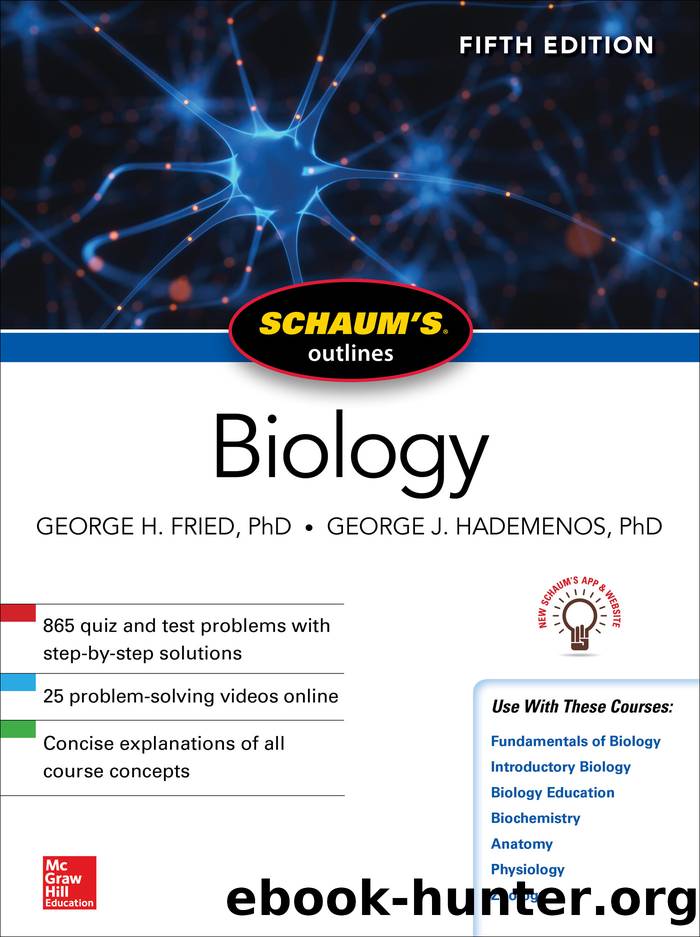Schaum's Outline of Biology by George H. Fried

Author:George H. Fried
Language: eng
Format: epub
Publisher: McGraw-Hill Education
Published: 2019-07-15T00:00:00+00:00
SOLUTIONS
1. (a) This homodont (having teeth of the same shape) pattern is characteristic of snakes. Because they eat their prey whole, they do not require a varied array of utensils in their mouths to break up the food. Lacking limbs, most cannot effectively grasp their prey by any other means than their mouths, so their teeth are sharp and recurved (bent backward) to make escape difficult and to aid in working their food down their throats.
(b) Grazing and browsing herbivores have a heterodont pattern; they use their six lower incisors to crop off grass and leaves and make use of the flat premolars and molars as grinding surfaces to break up the cellulose of the vegetation they eat.
(c) The well-developed canines are generally found in animals (such as canines) that must tear through meat; the sharp premolars and molars serve to cut and shear meat from bone.
2. Except for certain species of insects, no animal synthesizes its own cellulase (an enzyme). However, animals that can subsist on grass or wood generally enjoy a symbiotic relationship with bacteria or protozoans that are capable of synthesizing cellulase. Without cellulase, cellulose cannot be degraded. In the case of termites, which do so much damage to wooden structures (their major dietary staple), flagellated protozoa reside within the insect’s stomach. Since it is the protozoan that is vital to the digestion of the cellulose of wood, elaborate mechanisms exist for assuring its presence in every termite. Young termites are coprophagic—they eat the feces of their parents or other adults of the termite colony. This necessity for reinfecting the young may very well have been the significant factor in the evolutionary tendency toward a social system among termites.
3. Vomiting is a response to esophageal, gastric (stomachic), or intestinal irritation, including poisoning. Such irritation is best relieved through the elimination of the irritating food material. Vomiting is thus a valuable device to protect the organism. Even if ingested material is benign and the irritation is due to injury of the digestive tract itself, the elimination of food may provide much needed rest for the system. A clear-cut illustration of the value of vomiting is provided by the rat. This hardy creature would be all but invincible except for the fact that it lacks a vomiting reflex. Since it cannot rid itself of irritating poisons that are swallowed, the rat readily falls prey to a variety of poisons other species could eliminate through vomiting.
4. Increased length, (2) extensive folding (earthworms have a single large fold, the typhlosole), (3) projection of fingerlike villi into the intestinal lumen, (4) evagination of microvilli from epithelial cells of the mucosa.
5. Although both pepsin and chymotrypsin cleave polypeptides at tyrosine and phenylalanine, only pepsin does so at the amino side of the amino acid and thus leaves tyrosine or phenylalanine with a free amino group at the end of the hydrolyzed segment.
6. (a) True.
7. (b) False.
8. (b) False.
9. (a) True.
10. (e) mouth.
11. (c) ileum.
12. (d) colon.
13. (d) colon.
14. (b) duodenum.
15. (a) stomach.
Download
This site does not store any files on its server. We only index and link to content provided by other sites. Please contact the content providers to delete copyright contents if any and email us, we'll remove relevant links or contents immediately.
| ASVAB | GED |
| GRE | NCLEX |
| PRAXIS | SAT |
| See more | Flash Cards |
| Study Guides | Study Skills |
| Workbooks |
Talking to Strangers by Malcolm Gladwell(13290)
The Compound Effect by Darren Hardy(8870)
Tools of Titans by Timothy Ferriss(8304)
Wonder by R. J. Palacio(8057)
The Lover by Duras Marguerite(7856)
A Court of Wings and Ruin by Sarah J. Maas(7729)
The Circle by Dave Eggers(7063)
Deep Work by Cal Newport(6966)
Kaplan MCAT General Chemistry Review by Kaplan(6899)
To All the Boys I've Loved Before by Jenny Han(5805)
Wiseguy by Nicholas Pileggi(5707)
The Body: A Guide for Occupants by Bill Bryson(5027)
Eat That Frog! by Brian Tracy(4483)
1,001 ASVAB Practice Questions For Dummies by Powers Rod(4471)
Cracking the GRE Premium Edition with 6 Practice Tests, 2015 (Graduate School Test Preparation) by Princeton Review(4248)
Pre-Suasion: A Revolutionary Way to Influence and Persuade by Robert Cialdini(4182)
Barron's AP Biology by Goldberg M.S. Deborah T(4122)
ACT Math For Dummies by Zegarelli Mark(4021)
Alive: The Story of the Andes Survivors by Piers Paul Read(3996)
